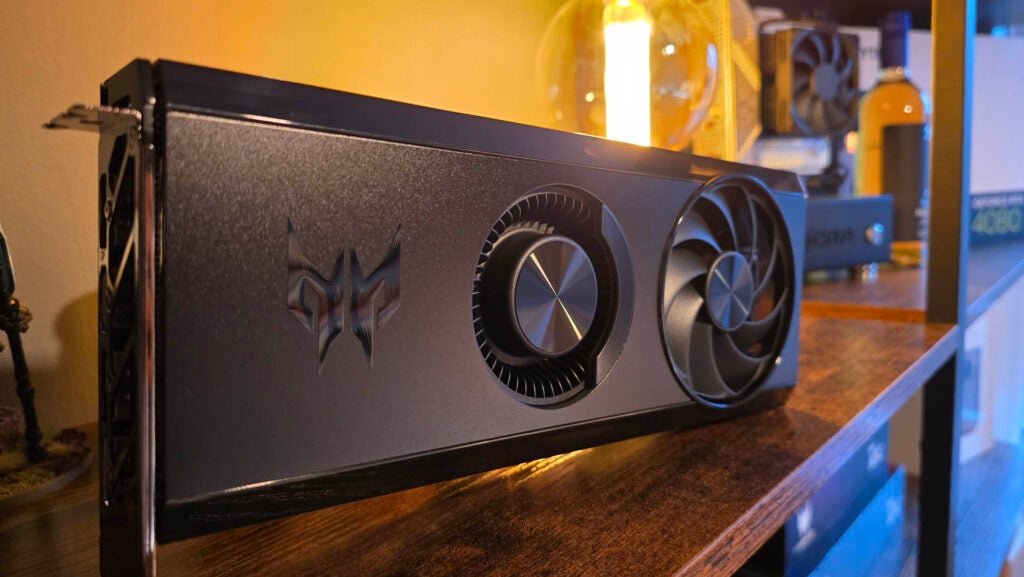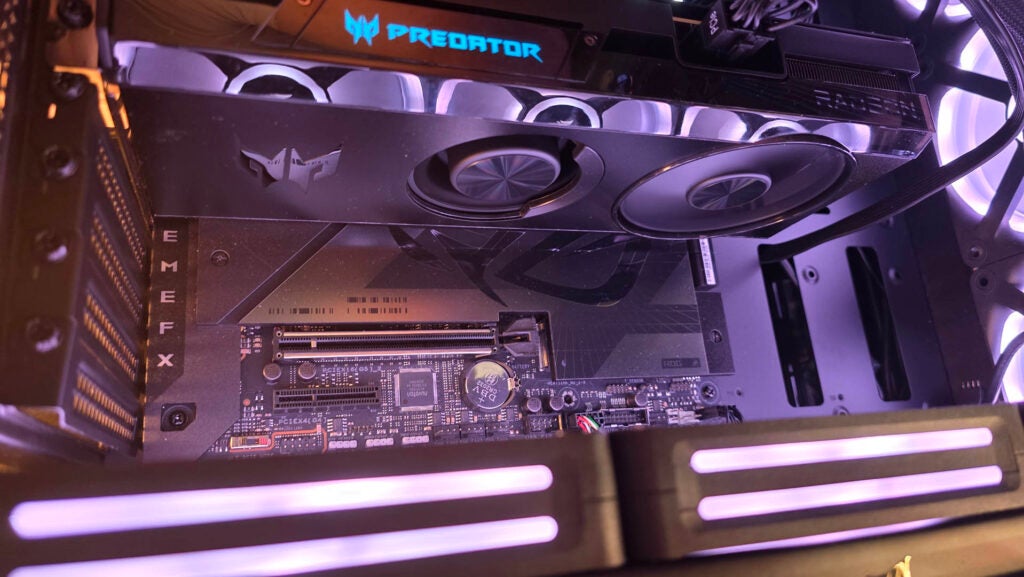AMD Radeon RX 7600 Review
Team Red’s ultimate budget GPU








Verdict
The AMD Radeon RX 7600 is an incredibly well-rounded 1080p and 1440p graphics card. With an ample amount of VRAM and impressive performance across a multitude of titles. The RX 7600 is ideal for those looking to keep their 1080p gaming rigs ticking along well into 2024 and beyond.
Pros
- Solid at 1080p and 1440p
- Incredible price to performance
- 8GB of VRAM is plenty
Cons
- Acer’s cooler design needs an upgrade
- Limited VRAM can hinder 4K performance
Key Features
- Latest technologyAMD’s built the RX 7600 solely around TSMC’s 7nm manufacturing process, combined with its RDNA 3 architecture to bring some top-tier performance to entry-level PC gaming.
- AI upscalingIf you do decide to leap into 4K gaming, AMD’s FSR 2.0 AI upscaling tech makes the ride a lot smoother, and it applies equally well at 1440p and 1080p too, massively boosting framerates.
- 1080p-friendly graphical memoryThe RX 7600 as standard only comes with 8GB of VRAM, however, that’s plenty if you’re only looking to game at 1080 or 1440p
Introduction
AMD’s Radeon RX 7600 may be getting a little long in the tooth now but, over the last year, it has absolutely matured as a graphics card. With a number of price cuts, it now ranks as one of the best value GPUs out there, particularly if you’re looking at building the ultimate gaming PC on a budget around that 1080p resolution.
Yes, it doesn’t quite have the same god-tier frame rate busting clout as something like the 7900 XTX or the Nvidia GeForce RTX 4080 Super, but what it lacks in streaming cores and VRAM it more than makes up for with a phenomenal price-to-performance ratio, combined with impressively low power draw at the same time.
Specs
- 8GB VRAM
- Low price point
- Monolithic GPU design unlike other AMD offerings
Now it’s worth mentioning that the RX 7600 has been superseded effectively by the RX 7600 XT. However, the only major change, beyond a price rise, comes in the form of slightly tweaked clock speeds and 8GB of extra VRAM.

That’s great if you want to game at 4K, and need that extra GDDR6 memory for those extra textures, but really, this card isn’t exactly designed for that. Yes, you can get away with 4K gaming, with the help of FSR 2.0, but that’s not supported in every title, and results can be a little odd every now and then as well, with slight graphical anomalies, dependent on the title.



At its heart, the RX 7600 features 2,048 shader cores, 128 TMUs, 64 ROPs, 32 Ray accelerators, 64 AI accelerators and 32 compute units total. Interestingly as it’s based on the Navi 33 die, this is one of the few GPUs from AMD that still features a monolithic die design, similar to that found in its Nvidia competitors like the RTX 4070 Super. Every model above the 7600 and the 7600 XT (basically Navi 32 and 31 GPUs) uses a modular chiplet design instead.
Otherwise, core clock speeds sit comfortably at 2,655 MHz boosted, and VRAM is accommodated with 8GB of GDDR6 sat on a 128-bit bus producing around 288 GB/s total bandwidth.
That is admittedly quite slow. For comparison, something like the AMD RX 7800 XT, actually pushes close to 624 GB/s across its 16GB of GDDR6.
Test Setup
I’ve spent the last couple of weeks testing a whole host of different graphics cards, trying to find the best budget GPUs out there today, particularly with the RX 7600 in mind. That includes benchmarking and re-testing everything from Intel’s Arc A750, to the RX 7600 XT, and even taking another look at the RTX 4070 Super from Nvidia.
To do that, I’ve picked a solid and stable test bench for these operations and paired it with an extensive array of benchmarks, both synthetic and real-world, to push these cards to their limits.
CPU: Intel Core i9-14900K
RAM: 32GB (2x16GB) Corsair Dominator Titanium @ 7200
Motherboard: ASUS ROG Maximus Z790 Dark Hero
CPU Cooler: Corsair iCUE Link H150i LCD 360mm AIO
Cooling: 8x Corsair iCUE Link QX120 120mm fans
PSU: 1200W Corsair RMx Shift 80+ Gold PSU
SSD: 2TB Gigabyte Aorus Gen5 12000 M.2 PCIe 5.0 SSD
Case: Geometric Future Model 8 Dharma
Our synthetic testing consists of a mix of 3D Mark and Blender benchmarks, as this gives us a nice index to work with, and generally runs very consistently across platform and generation too. I’ve only had one set of cards fail 3D Mark tests, that being Intel’s Arc A770 and A750 not completing on the DX12 Speedway test.

As for gaming, each GPU is tested at all three key resolutions, across seven different titles, monitoring average and minimum frame rates. I’m using a mix of games here, some running on Vulkan, DX12, and DX11, along with a few ray tracing titles as well. Each game is tested on the Ultra or highest graphical preset available, and any games that enable DLSS, FSR or Intel’s XeSS by default, have it disabled for the duration of the testing, although more on that later.
Performance and Benchmarks
- Perfect for 1080p AAA gaming
- Can keep up with 7600 XT in 1440p
- 4K gaming performance limited
When it came to our gaming benchmarks, the RX 7600 did surprisingly well all things considered. It smashed the 1080p tests, scoring well over 100 in Horizon Zero Dawn, Borderlands 3 and Shadow of the Tomb Raider. Total War: Warhammer 3 also hit 85, and F1 2022 landed at 58 with Red Dead at 76 too.
Cyberpunk 2077 however was another beast, and with FSR disabled, and ray tracing enabled the RX 7600 scored an impressively low 11 fps, even at 1080p, That’s half what the RX 7600 XT achieved, despite featuring identical core counts. At a guess, this is likely the VRAM being a limiting factor, particularly coupled with Cyberpunk’s aggressive ray tracing, and lack of FSR during the test. Still, this is incredibly low regardless.
Jumping up to 1440p and average frame rates equally floated around the 60 fps mark, with Cyberpunk again bringing the score lower, and most titles skipping along pleasantly well above that sweet spot we all know and love.
At 4K, I started to encounter a number of graphical anomalies with certain benchmarks. Horizon Zero Dawn in particular had problems with texture pop-in and low-res textures appearing consistently, mid-way through each benchmark attempt, the game would crash entirely and lock up the entire system as it did so. Similarly, Cyberpunk’s average frame rate at 4K dropped to slideshow speed at just 2 fps, showing exactly what 8GB of VRAM on a 128-bit bus can do.
Still given the price, the RX 7600 is a phenomenal piece of kit, particularly at 1080p\ and 1440p, you’ve just got to tweak the settings a bit in the more aggressively ray-traced titles.
Ray Tracing and Upscaling
- FSR 2.0 performs well, doubling frame rate
- FSR isn’t supported across all titles
- Ray tracing performance is generally solid
As with all of our GPUs, I also test how they perform with ray tracing and AI upscaling as well. Depending on the brand of GPU under the microscope, I do this with its own AI upscaling tech enabled. For Nvidia that’s DLSS, for AMD FSR 2.0, and for Intel, XeSS.
All the tests are performed at 4K, in four different configurations, one with ray tracing and AI upscaling off, one with just ray tracing on, one with just AI upscaling on, and one with both on. Admittedly both Intel’s XeSS and AMD’s FSR 2.0 are open-source and available on all GPUs, so you can mix and match depending, but this is more to examine how each manufacturer’s tech performs comparatively to one another on their cards and should be viewed with that in mind.
That said, the RX 7600 and FSR 2.0 do very well. With ray tracing and FSR enabled it takes that 2 fps average frame rate in Cyberpunk at 4K and bumps it all the way to 14. Bearing in mind this still isn’t a 4K card that’s a 700% improvement, although it’s still not playable at 14 fps. With ray tracing disabled and using FSR only, Cyberpunk goes from 21 fps to 49, a far more impressive achievement.
F1 2022 also saw similar results, with ray tracing going from 13 to 32 with FSR, and no ray tracing going from 53 to 73 respectively. Unfortunately in Shadow of the Tomb Raider, FSR isn’t supported, however, we can see that ray tracing generally does pull the frame rate down from 40 to 20 fps at 4K.
Power Consumption and Temperature
Acer’s Predator BiFrost OC card paired with that RX 7600 GPU is nothing short of monstrous. Its max clock speed throughout my testing topped out at an incredible 2,966 MHz. That is phenomenally quick and makes it the fastest card I’ve tested here at Trusted Reviews, at least from a clock-speed perspective. On top of that power-draw was equally well constrained too, topping out at 543 W total system draw, in line with the 7600 XT, and substantially lower than every other card tested including Intel’s Arc A750.
The Predator BiFrost keeps the card cool too, with the GPU temp never going beyond 75.4 C, and GPU hot spot staying steady at 94.0 C, significantly lower than the 7600 XT’s 115, or the 7800 XT’s 106 C.
Latest deals
Should you buy it?
You want the a great value GPU
The AMD Radeon RX 7600 is one of the best value GPUs out there, particularly if you’re focused on 1080p or 1440p gaming. It does have its limits, particularly with some texture-heavy titles, but with a bit of setting tweaking, it’ll quite happily hit that 60 fps mark with them.
You’re looking for 4K gaming
Thanks to that 8GB of VRAM, 4K gaming, although possible, isn’t entirely recommended. You’ll likely experience texture pop-in, and other graphical anomalies, certainly without the help of AMD’s FSR upscaling tech.
Final Thoughts
AMD Radeon RX 7600 is a stellar GPU. Its fantastic architecture combined with an impressive overall card design, and phenomenal price point makes it a solid contender as one of the best value graphics cards money can buy right now. Compared to the RX 7600 XT the only thing that’s changed is the VRAM, and you’ll only need that if you’re dabbling in 4K, and to be honest, neither card is suited to it.
If 4K gaming is your thing, AMD has answers in the form of the 7800 XT and higher, really though, you want something a bit more along the lines of Nvidia’s RTX 4070 Super. It’s far more potent, particularly in the ray tracing department, although you do have to pay a premium for that extra performance.
How we test
Each of the graphics cards we test is installed into a dedicated test bed. After which, multiple different benchmarks are run to stress test the card, at a variety of different resolutions. We also monitor power draw and temperature throughout this procedure.
Installed into a dedicated test bed
Tested using game benchmarks
Energy and temperature monitored
FAQs
Yes, it easily hits 60 fps across most titles at 1440p.








